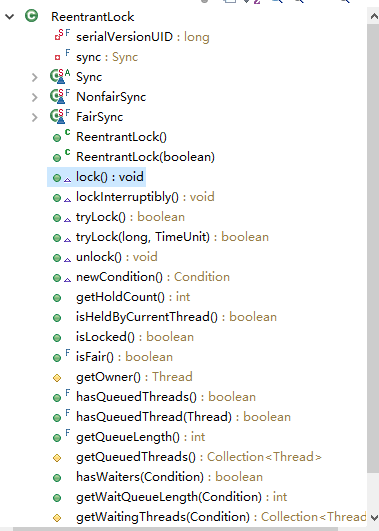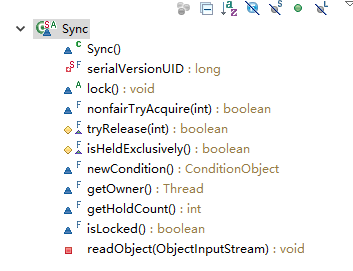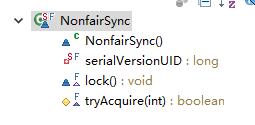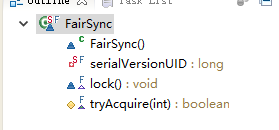参考文档:
Java多线程系列--“JUC锁”02之 互斥锁ReentrantLock:http://www.cnblogs.com/skywang12345/p/3496101.html
ReentrantLock介绍
ReentrantLock是一个可重入的互斥锁,又被称为“独占锁”
ReentrantLock分为“公平锁”和“非公平锁”。它们的区别体现在获取锁的机制上是否公平。ReentraantLock是通过一个FIFO的等待队列来管理获取该锁所有线程的
公平锁:线程依次排队获取锁
非公平锁:在锁是可获取状态时,不管自己是不是在队列的开头都会获取锁
ReentrantLock函数列表

// 创建一个 ReentrantLock ,默认是“非公平锁”。 ReentrantLock() // 创建策略是fair的 ReentrantLock。fair为true表示是公平锁,fair为false表示是非公平锁。 ReentrantLock(boolean fair) // 查询当前线程保持此锁的次数。 int getHoldCount() // 返回目前拥有此锁的线程,如果此锁不被任何线程拥有,则返回 null。 protected Thread getOwner() // 返回一个 collection,它包含可能正等待获取此锁的线程。 protected Collection<Thread> getQueuedThreads() // 返回正等待获取此锁的线程估计数。 int getQueueLength() // 返回一个 collection,它包含可能正在等待与此锁相关给定条件的那些线程。 protected Collection<Thread> getWaitingThreads(Condition condition) // 返回等待与此锁相关的给定条件的线程估计数。 int getWaitQueueLength(Condition condition) // 查询给定线程是否正在等待获取此锁。 boolean hasQueuedThread(Thread thread) // 查询是否有些线程正在等待获取此锁。 boolean hasQueuedThreads() // 查询是否有些线程正在等待与此锁有关的给定条件。 boolean hasWaiters(Condition condition) // 如果是“公平锁”返回true,否则返回false。 boolean isFair() // 查询当前线程是否保持此锁。 boolean isHeldByCurrentThread() // 查询此锁是否由任意线程保持。 boolean isLocked() // 获取锁。 void lock() // 如果当前线程未被中断,则获取锁。 void lockInterruptibly() // 返回用来与此 Lock 实例一起使用的 Condition 实例。 Condition newCondition() // 仅在调用时锁未被另一个线程保持的情况下,才获取该锁。 boolean tryLock() // 如果锁在给定等待时间内没有被另一个线程保持,且当前线程未被中断,则获取该锁。 boolean tryLock(long timeout, TimeUnit unit) // 试图释放此锁。 void unlock()
举个栗子

public class ConditionTest { private static Lock lock = new ReentrantLock(); private static Condition condition = lock.newCondition(); public static void main(String[] args) { ThreadA ta = new ThreadA("t"); lock.lock(); // 获取锁 try { System.out.println(Thread.currentThread().getName() + " start ta"); ta.start(); System.out.println(Thread.currentThread().getName() + " block"); condition.await(); // 等待 System.out.println(Thread.currentThread().getName() + " continue"); } catch (Exception e) { e.printStackTrace(); } finally { lock.unlock(); // 释放锁 } } static class ThreadA extends Thread { public ThreadA(String name) { super(name); } public void run() { lock.lock(); // 获取锁 try { try { Thread.sleep(1000*5); } catch (InterruptedException e) { e.printStackTrace(); } System.out.println(Thread.currentThread().getName() + " wakup others"); condition.signalAll(); // 唤醒“condition所在锁上的其它线程” } finally { lock.unlock(); // 释放锁 } } } }
源码分析




lock-公平锁(FairSync extends Sync)
final void lock() { acquire(1); }
protected final boolean tryAcquire(int acquires) { final Thread current = Thread.currentThread(); int c = getState(); if (c == 0) {// c=0 说明没有其他线程占有锁 if (!hasQueuedPredecessors() && compareAndSetState(0, acquires)) {// 队列中没有其他线程在等待锁,而且CAS把state设置成入参的值成功,这里是1(这里的CAS就是我 // 们前文提的并发竞争机制),则当前线程获取锁成功并将owner线程设置为当前线程 setExclusiveOwnerThread(current); return true; } } else if (current == getExclusiveOwnerThread()) {// 可重入设置,当前线程重复请求锁成功,只是增加请求锁的计数 int nextc = c + acquires; if (nextc < 0) throw new Error("Maximum lock count exceeded"); setState(nextc); return true; } return false; }
lock-非公平锁(NonfairSync extends Sync)
final void lock() { if (compareAndSetState(0, 1))//先去cas设置锁 setExclusiveOwnerThread(Thread.currentThread()); else acquire(1);//获取锁失败,再try }
protected final boolean tryAcquire(int acquires) { return nonfairTryAcquire(acquires); }
final boolean nonfairTryAcquire(int acquires) { final Thread current = Thread.currentThread(); int c = getState(); if (c == 0) {//如果当前没有线程持有锁,不管等待队列里有没有等待的线程,都直接去请求锁 if (compareAndSetState(0, acquires)) { setExclusiveOwnerThread(current); return true; } } else if (current == getExclusiveOwnerThread()) {//可重入 int nextc = c + acquires; if (nextc < 0) // overflow throw new Error("Maximum lock count exceeded"); setState(nextc); return true; } return false; }
unlock (公平锁和非公平锁的实现是一样的)
public void unlock() { sync.release(1); }
public final boolean release(int arg) { /* 尝试释放锁如果失败,直接返回失败,如果成功并且head的状态不等于0就唤醒后面等待的节点 */ if (tryRelease(arg)) { Node h = head; if (h != null && h.waitStatus != 0) unparkSuccessor(h); return true; } return false; }
protected final boolean tryRelease(int releases) { // 释放后c的状态值 int c = getState() - releases; // 如果持有锁的线程不是当前线程,直接抛出异常 if (Thread.currentThread() != getExclusiveOwnerThread()) throw new IllegalMonitorStateException(); boolean free = false; if (c == 0) { // 如果c==0,说明所有持有锁都释放完了,其他线程可以请求获取锁 free = true; setExclusiveOwnerThread(null); } // 这里只会有一个线程执行到这,不存在竞争,因此不需要CAS setState(c); return free; }
